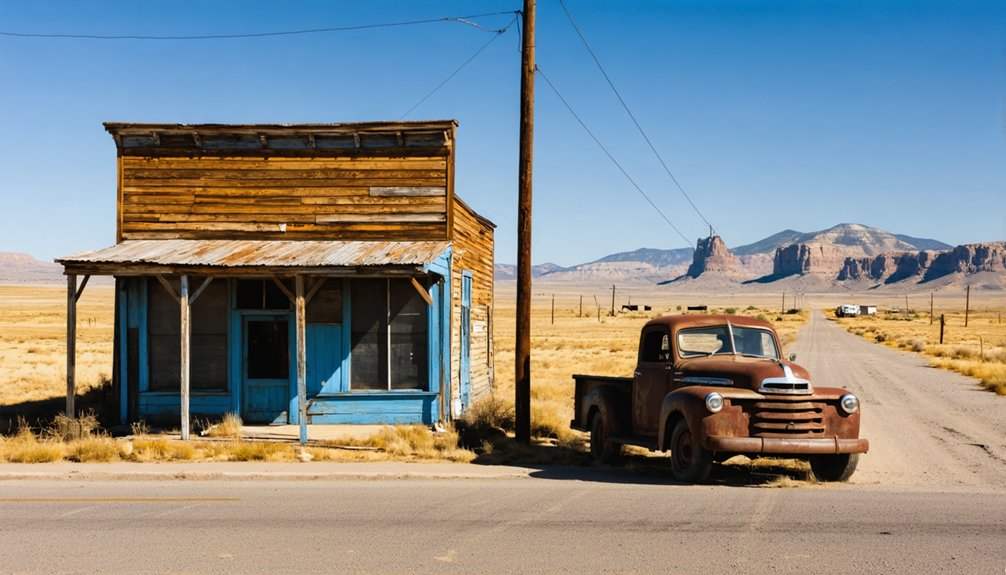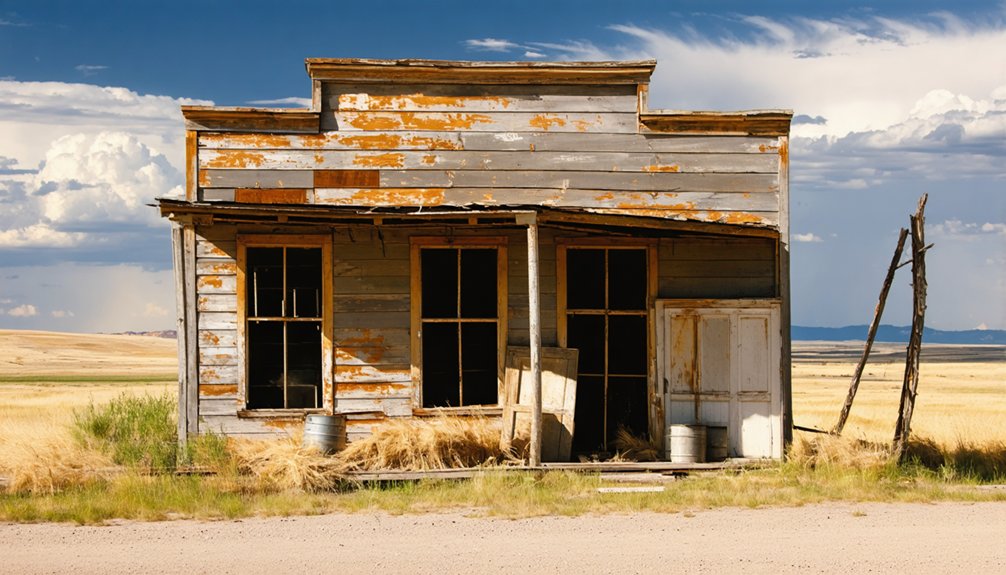You’ll find Keota as a windswept ghost town in northeastern Colorado, founded in 1880 by sisters Mary and Eva Beardsley. This once-thriving community flourished after the railroad’s 1887 arrival but couldn’t survive devastating droughts, harsh winters, and economic depression. Today, only the silver water tower, scattered foundations, and a cemetery with graves spanning 1900-2013 remain. These silent sentinels tell tales of ambitious dreams crushed against the unforgiving prairie.
Key Takeaways
- Keota was established in 1880 by the Beardsley sisters and grew into a railroad hub before declining into a ghost town.
- The Chicago, Burlington and Quincy Railroad fueled Keota’s growth until tracks were removed in 1982, severing its economic lifeline.
- Environmental challenges including drought and harsh winters, coupled with agricultural mismanagement, contributed to the town’s abandonment.
- The silver water tower remains standing as a prominent landmark symbolizing Keota’s struggle against harsh plains conditions.
- The cemetery with gravestones dating from the early 1900s to 2013 preserves the community’s history, including the 1918 flu epidemic.
The Origins of a Prairie Homestead (1880-1888)
As the harsh winds swept across the northeastern Colorado prairie in 1880, two determined sisters, Mary and Eva Beardsley, established what would become the humble settlement of Keota.
You’ll find this homestead perched at nearly 5,000 feet above sea level in what’s now the southwest corner of Pawnee National Grassland, its name meaning “gone to visit” or “the fire goes out” in Native American language.
Despite homesteading challenges in this arid landscape, the sisters’ vision attracted a community of resilient farmers.
After eight years, they sold to Lincoln Land and Cattle Co., shifting from individual settlement to corporate agriculture.
Though Keota never grew beyond 150 residents, it served as a crucial hub for 1,250 surrounding homesteads, demonstrating how even small outposts could sustain frontier life on the unforgiving plains.
The town eventually became an official stop along the Chicago, Burlington & Quincy rail line in 1888, marking the beginning of its formal existence.
The sisters established a school foundation in 1880 that remains visible to this day, showing their commitment to education even in frontier conditions.
Railroad Arrival and Early Economic Booms
When the Chicago, Burlington and Quincy Railroad extended its steel lifeline through Keota in 1887, the isolated prairie settlement’s future transformed overnight.
You could witness Keota’s rapid evolution into a crucial hub on the “Old Prairie Dog Express,” connecting Cheyenne to Sterling. The railroad’s significance extended beyond mere transportation—it became Keota’s lifeline, sometimes delivering water to this dry plains outpost.
Local ranchers thrived as cattle shipments flowed efficiently through the new station, while nearby sugar beet farmers benefited from expanded rail networks by 1906. Similar to how early settlers relied on the Erie Canal for goods transport beginning in 1825, these railroad connections revolutionized rural market access.
The economic impact rippled through the community as newspapers, a post office, and various services emerged alongside improved roads and infrastructure. To avoid confusion with other locations, travelers and correspondents needed to specify Keota, Colorado when referencing this particular frontier community.
This symbiotic relationship between rail and town would sustain Keota’s liveliness until the tracks were removed in 1982, marking the beginning of its decline.
Daily Life in a Thriving Rural Community
In Keota’s heyday, you’d have found settlers from Scandinavian countries establishing bustling commerce at the general store, where farming families traveled miles to exchange news and purchase essential supplies.
You might’ve joined one of the many social gatherings that punctuated prairie isolation, with community chicken dinners and neighborhood visits connecting the widely dispersed homesteads that relied on each other’s support. These gatherings became crucial sources of emotional support during times of hardship and celebration alike.
The town’s newspaper kept you informed of local happenings across the 1,250 surrounding homesteads, creating a cohesive social fabric despite the vast distances separating neighbors on the harsh eastern plains. Children attended the one-room schoolhouse where 12-15 students of varying ages learned together under a single teacher’s guidance.
Bustling Prairie Commerce
Though Keota’s permanent population never swelled beyond 150 souls, this modest prairie settlement served as the commercial heartbeat for over 1,250 surrounding homesteads.
On Saturdays, you’d witness the transformation as farmers converged on Stanley’s general store, their buggies and Model Ts lining Ironic Avenue in a display of rural market dynamics.
The railroad connection via the “Old Prairie Dog Express” revolutionized trading practices, enabling cattle shipments to Sterling and bringing essential water supplies to this isolated outpost. The iconic water tower remains one of the few standing structures in what is now a ghost town.
During WWI, wheat demand surged, fueling unprecedented economic growth. The town’s commercial infrastructure expanded to include a high school, newspaper, church, and professional services—all supporting regional commerce.
At Stanley’s store, you could exchange farm goods for groceries, conduct business, and most importantly, find human connection on the isolated prairie.
The vibrant social heartbeat of Keota truly came alive through its Scandinavian immigrant gatherings, where community bonds flourished amid the harsh prairie isolation.
You’d find Court Scandia No. 9 hosting multiple meetings monthly, creating spaces for cultural preservation while providing essential mutual aid for newcomers.
These gatherings weren’t merely social—they embodied cooperative values that extended beyond festivities into daily life. Members prioritized maintaining their Swedish heritage while following the example of Chicago’s Swedish community, which had grown to become the second largest Swedish city in the world outside of Sweden.
You could join traditional Midsummer celebrations with flower crowns and folk dancing, or participate in community skiing events that united all ages.
The cooperative model permeated every aspect of Scandinavian life, from shared farming equipment to communal stores.
Through these social connections, immigrants maintained their heritage while adapting to frontier challenges, creating a resilient community bonding experience that defined Keota’s Scandinavian identity.
Residents eagerly anticipated annual festivals featuring traditional aquavit alongside other Scandinavian culinary specialties that reminded them of their homeland.
Environmental Challenges and Agricultural Struggles
Despite initial promises of prosperity, Keota’s settlers soon faced devastating environmental challenges that would ultimately seal the town’s fate. You’d have witnessed the heartbreaking drought challenges by 1890, as families watched their crops wither under relentless sun and unpredictable rainfall patterns.
The farming failures stemmed from fatal misconceptions. Settlers, armed with the misguided belief that “rain follows the plow,” stripped away native prairie grasses that had protected the soil for centuries.
When drought inevitably struck, overplowed fields surrendered their precious topsoil to howling winds. The harsh winter conditions created freezing temperatures that further challenged the struggling agricultural community.
Economic depression compounded these natural hardships. Markets collapsed, and the feast-or-famine precipitation cycle made consistent agriculture impossible.
Despite temporary relief during wet years around 1909, the harsh reality remained—this land wasn’t meant for traditional farming, and freedom-seeking homesteaders paid the ultimate price.
The Slow Decline of a Once-Vibrant Town

Once a promising hub of frontier ambition, Keota entered a prolonged decline that would transform it from bustling settlement to windswept ghost town over several decades.
You can trace the town’s fading heartbeat through key moments of community resilience and surrender. The Depression following the initial boom forced many residents to abandon their dreams.
Despite brief revivals, particularly around 1909, the town couldn’t sustain its liveliness. The school’s closure in 1951 removed a significant anchor, while the railroad’s abandonment in 1970 severed Keota’s economic lifeline.
What Remains: Exploring Keota Today
As you approach Keota on Weld County Road 390, you’ll notice the silver water tower standing like a sentinel over the abandoned prairie town.
The cemetery, with gravestones dating from the early 1900s to as recently as 2013, remains the most active element of this ghost town, telling stories of harsh prairie life through markers for residents as young as two years old.
Between the general store ruins, scattered house foundations, and persistent sidewalks, you’re walking through physical remnants of a community that time hasn’t completely erased.
Water Tower Sentinel
Standing tall against the eastern Colorado sky, the Keota water tower serves as a silent sentinel over what remains of this once-thriving prairie community.
Though no longer operational, this rusting landmark symbolizes Keota’s struggle against harsh plains conditions. You’ll spot it immediately from Weld County Road 390, marking your entrance to the ghost town.
- The tower once stored precious water delivered by rail cars to this isolated settlement.
- Its weathered frame has outlasted most town structures, which are now crumbling ruins.
- Despite decades of abandonment, it remains relatively untouched by vandalism.
The water tower’s historical significance stretches beyond mere infrastructure—it represents the backbone of pioneer life, supporting generations of ranchers and farmers who battled drought and isolation to build their prairie dreams.
Cemetery Tells Stories
The weathered headstones of Keota Cemetery tell stories more poignant than any history book could capture. As you navigate the gravel back roads to this private property, you’ll discover grave markers that span generations, including heartbreaking memorials to children who died during the 1918 flu epidemic.
The cemetery’s neglected state—with tilted stones and sunken plots—mirrors the town’s abandonment, yet families still visit. Recent offerings of identical stuffed animals on children’s graves suggest coordinated remembrance during annual Keota Celebrations.
Among these historical narratives, you’ll find notable burials including Edith Grace Steiger Philips and founding settlers like John Hart. Despite warnings against trespassing, this sacred ground continues serving as both genealogical archive and emotional touchstone for descendants who refuse to let Keota’s memory fade.
Frequently Asked Questions
Why Was the Name “Keota” Chosen for the Settlement?
You’ll find Keota’s significance in its Sac & Fox tribal origins meaning “Fire ALL Out” or “Safe to go to bed.” The Beardsley sisters embraced this Native American heritage when establishing your settlement’s history.
Were Any Movies or Television Shows Filmed in Keota?
You’ll find Keota’s modest film history captured in Rob Zombie’s “House of 1000 Corpses” and “The Devil’s Rejects,” particularly at Capt Spaulding’s house. Its cinematic influence remains limited to cult horror fame.
What Happened to Keota During Prohibition and the Dust Bowl?
You’d have witnessed Keota’s gradual decline during Prohibition’s economic impact, then watched as Dust Bowl effects devastated the already struggling agricultural community, accelerating the exodus of families from this once-hopeful prairie settlement.
Are There Any Local Legends or Ghost Stories About Keota?
You’ll hear whispers of Keota’s haunted history through tales of children’s spirits wandering the cemetery. Locals speak of spectral sightings near abandoned buildings and mysterious calls drawing visitors deeper into the town’s forgotten past.
Can Visitors Legally Explore the Keota Site Today?
Yes, you can legally explore Keota’s decades-old structures. Among visitor guidelines, remember that 50 miles from Fort Collins, exploration regulations are minimal—the site lost township status in the 1990s, leaving these ghostly remnants accessible year-round.
References
- https://www.kunc.org/arts-life/2014-09-25/arid-adversity-of-prairie-life-has-yet-to-erase-keota-colorado
- https://95rockfm.com/colorado-ghost-town-cemetery-young-graves/
- http://coloradosghosttowns.com/page322.html
- https://www.youtube.com/watch?v=B46WOV2Gzck
- https://www.ghosttowns.com/states/co/keota.html
- https://www.rmpbs.org/shows/colorado-experience/episodes/colorado-experience-keota
- https://history.weld.gov/files/sharedassets/history/v/2/documents/county-150/weld-county-towns/keota.pdf
- https://www.youtube.com/watch?v=QW5dJh7bew4
- https://www.youtube.com/watch?v=xqZq9QmPc8Q
- https://history.weld.gov/County-150/Transportation/Railroads



